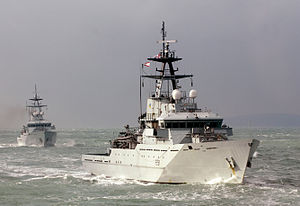 HMS Tyne on exercise in 2011
| |
| History | |
|---|---|
| Name | HMS Tyne |
| Ordered | April 2001 |
| Builder | Vosper Thornycroft |
| Launched | 1 July 2002 |
| Commissioned | 4 July 2003 |
| Homeport | Portsmouth |
| Identification |
|
| Status | In active service |
| Badge |  |
| General characteristics | |
| Class and type | River-class patrol vessel |
| Displacement | 1,700 tonnes[1] |
| Length | 79.5 m (260 ft 10 in) |
| Beam | 13.5 m (44 ft 3 in) |
| Draught | 3.8 m (12 ft 6 in) |
| Installed power | 4,125 kW (5,532 hp) at 1,000 rpm |
| Propulsion | Two Ruston 12RK 270 diesel engines |
| Speed | 20 knots (37 km/h; 23 mph) |
| Range | 5,500 nmi (10,200 km; 6,300 mi) |
| Endurance | 21 days |
| Boats & landing craft carried | 2 × rigid inflatable boats |
| Troops | 20 |
| Complement | 30 |
| Armament | |
| Notes | Fit with 25-tonne crane[2] |
HMS Tyne is a River-class offshore patrol vessel built by Vosper Thornycroft in Southampton for the Royal Navy to serve as a fishery protection unit within the United Kingdom's waters along with her two sister ships Mersey and Severn. All three were commissioned into service in 2003 to replace the five older Island-class patrol vessels.
Tyne is the sixth Royal Navy ship to carry the name and was featured in the first episode of the BBC series Empire of the Seas, "How the Navy Forged the Modern World, Heart of Oak", presented by Dan Snow.
- ^ "Offshore Patrol Vessels". BAE Systems. Retrieved 8 June 2014.
- ^ "River Class". Naval Technology. Retrieved 19 October 2019.